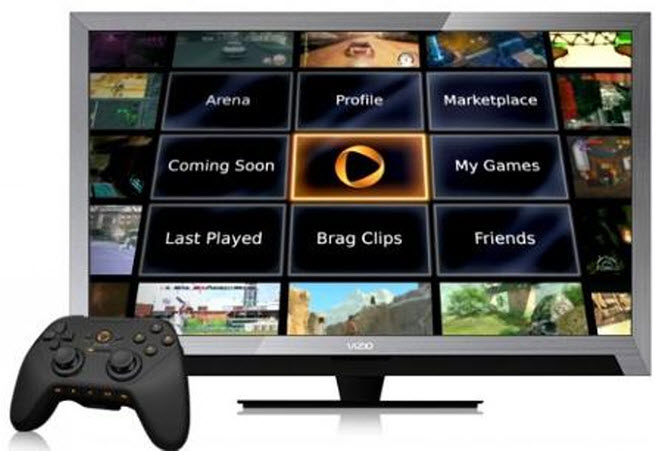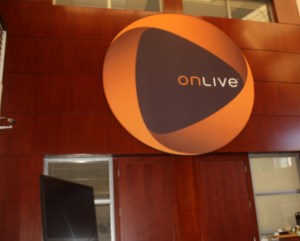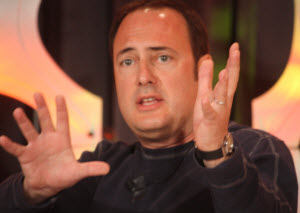 OnLive began with a radical promise: the capability to play high-end PC and console games on low-end devices. Many were skeptical of the cloud gaming company’s ambitions, but it fought back with a slew of partnerships and expansions into a variety of devices, including mobile phones and tablets. But serial entrepreneur Steve Perlman delivered a service that lived up to what its promise, allowing gamers to instantly play more than 200 3D titles.
OnLive began with a radical promise: the capability to play high-end PC and console games on low-end devices. Many were skeptical of the cloud gaming company’s ambitions, but it fought back with a slew of partnerships and expansions into a variety of devices, including mobile phones and tablets. But serial entrepreneur Steve Perlman delivered a service that lived up to what its promise, allowing gamers to instantly play more than 200 3D titles.
Unfortunately, OnLive couldn’t sustain itself, leading to its recent financial upheavals, angry ex-employees, and the eventual resignation of its founder and chief executive, Perlman. Here’s our chronology of the life of OnLive.
August 27, 2012: Perlman departs from OnLive to “work on his myriad of other projects.” Charlie Jablonski becomes the company’s new chief operating officer and acting chief executive, while investor Gary Lauder becomes chairman. COO Etienne Handman moves to become its chief financial officer.
August 25, 2012: Steve Perlman donates $50,000 to a fund to help former OnLive employees pay for their health-care costs.
August 23, 2012: According to the San Jose Mercury News, OnLive owed an estimated $30 million to $40 million in debts to its creditors and was on the verge of shutting down. An affiliate of Lauder Partners bought OnLive’s assets as a way to save the company from bankruptcy. A spokesman later said the estimate was too high.
August 19, 2012: OnLive addresses the sudden change in company ownership, saying that its board of directors decided to restructure under the California law known as “Assignment for the Benefit of Creditors.” That allowed the company to sell its assets to a company run by its investor, Lauder Partners, but it wiped out the equity stakes of other investors, Perlman, and all employees.
August 17, 2012: Rumors start circulating on Twitter that OnLive is shutting down. After a few hours of confusion, it’s later revealed that OnLive would continue to operate its services uninterrupted, but all of its assets have been sold to a then-undisclosed company. Some employees at the Palo Alto, Calif., headquarters were seen leaving with boxes full of their belongings. Vizio begins shipping TV-based technology with OnLive built into it.
July 30, 2012: OnLive finally launches in Belgium.
July 11, 2012: OnLive partners with Marvell, an integrated silicon solutions company, to bring the service to Google TVs and Google TV-enabled devices.
 June 5, 2012: At E3, OnLive announces that its game streaming service is being demonstrated on next-generation LG smart TVs, and that its enabled in-browser cloud gaming. The new MultiView feature also makes its debut.
June 5, 2012: At E3, OnLive announces that its game streaming service is being demonstrated on next-generation LG smart TVs, and that its enabled in-browser cloud gaming. The new MultiView feature also makes its debut.
March 1, 2012: The OnLive desktop app becomes available on Android tablets.
February 22, 2012: The OnLive Desktop Plus iOS app launches with a super-fast web browser.
January 11, 2012: OnLive’s viewer app will be integrated with Google televisions; for now, it’s restricted to just a spectator mode.
January 9, 2012: The OnLive desktop app goes live, giving iPad users access to fully featured desktop applications like Microsoft Word.
December 7, 2011: The OnLive app launches for iOS and Android devices, offering users a way to play console and PC games on the go.
November 21, 2011: OnLive publishing chief John Spinale leaves to become head of social games at Disney.
September 21, 2011: The U.K. version of its streaming service debuts during the Eurogamer Expo in London.
August 10, 2011: OnLive announces that the service will be launching in the United Kingdom on September 22. This is the first major international expansion for the company.
June 7, 2011: OnLive shows the service works on tablets and smartphones.
 June 2, 2011: The company announces a string of new partnerships right before the Electronic Entertainment Expo, including a deal that makes it easier to share a user’s exploits with friends on Facebook.
June 2, 2011: The company announces a string of new partnerships right before the Electronic Entertainment Expo, including a deal that makes it easier to share a user’s exploits with friends on Facebook.
May 26, 2011: OnLive nabs an exclusive PC demo of THQ’s Red Faction: Armageddon, marking the first time any major new video game will be available only to PC gamers through its cloud gaming service.
February 25, 2011: OnLive announces that anyone who preorders THQ’s Homefront from February 25 to March 14 will receive the OnLive Game System for free, which includes the MicroConsole and a wireless controller. February 8, 2011: OnLive raises $40 million from the Taiwan-based HTC, one of the fastest-growing makers of smartphones. The valuation suggested OnLive might be worth $1.8 billion.
February 1, 2011: The PlayPack subscription model launches.
January 4, 2011: At the Consumer Electronics Show, OnLive partners with Vizio to offer its game streaming service in the electronic manufacturer’s line of flatscreen TVs. 
January 3, 2011: Etienne Handman, former executive at music streaming service Pandora, is now the chief operating officer of OnLive. Former COO Mike McGarvey shifts positions to become the company’s chief strategy officer.
December 14, 2010: OnLive receives the patent Perlman filed in 2002. Perlman claims it is “fundamental” to cloud gaming.
December 7, 2010: A limited version of the service becomes available for the iPad, where you can spectate live streams of games and also use Windows 7 apps.
December 6, 2010: According to the Wall Street Journal, the company plans to expand its service to include movie streaming in 2011.
December 2, 2010: OnLive reveals an all-you-can-eat subscription plan at $9.99 a month, called the PlayPack subscription.
November 17, 2010: Presales for OnLive’s MicroConsole begins, which allows customers to use the service on a TV.
October 13, 2010: OnLive users in the U.S. can now play their games while traveling overseas.
October 4, 2010: OnLive gets rid of its monthly fee; users just have to pay for the games themselves.
 September 2, 2010: The company begins a beta test for Wi-Fi support of its growing service.
September 2, 2010: The company begins a beta test for Wi-Fi support of its growing service.
August 23, 2010: OnLive subscribers score same-day access to 2K Game’s Mafia II.
August 4, 2010: According to a regulatory filing in the state of Delaware, OnLive’s latest valuation is an estimated $1.1 billion.
June 29, 2010: Lego: Harry Potter Years 1-4 becomes the first game to simultaneously debut in stores and in the OnLive service.
June 22, 2010: The OnLive service is live, with positive first impressions.
June 15, 2010: OnLive announces its launch lineup, which consists of 15 titles, including Assassin’s Creed 2 and Mass Effect 2. Dell is also announced to be the server partner for OnLive.
May 17, 2010: Belgacom Group joins a growing list of investors for OnLive, also taking a 2.6 percent stake. Belgacom will help launch the service in Belgium and Luxembourg.
May 13, 2010: BT, the former British Telecommunications, invests in OnLive in a new round of funding, taking a 2.6 percent stake as part of a plan to expand the service to Europe.
March 12, 2010: At the OnLive GDC after-party, Perlman announces the OnLive Game Portal, a free companion to the game streaming service. It allows players to play game demos for free. March 10, 2010: During the GamesBeat@GDC conference, Perlman reveals OnLive’s launch date (June 17), subscription price ($14.95 a month), and supporting game publishers (including Electronic Arts and Ubisoft).
February 18, 2010: During the 2010 Dice Summit in Las Vegas, Perlman shows a live demo of OnLive running Unreal Tournament and Burnout: Paradise. It works flawlessly.
 January 21, 2010: A PC blogger who receives access to OnLive’s closed beta test gives it a bad review, but Perlman responds saying that the blogger is too far (at 2,100 miles away from the company’s server in California) to reflect a fair test. The user is meant to be within a 1,000 miles of an OnLive server.
January 21, 2010: A PC blogger who receives access to OnLive’s closed beta test gives it a bad review, but Perlman responds saying that the blogger is too far (at 2,100 miles away from the company’s server in California) to reflect a fair test. The user is meant to be within a 1,000 miles of an OnLive server.
January 15, 2010: GamesBeat announces that Steve Perlman will be the keynote speaker at the GamesBeat@GDC conference in March of that year.
November 13, 2009: In New York at a Wedbush financial conference, Steve Perlman demonstrates that OnLive could work simultaneously cell phones, TVs, and computers.
September 29, 2009: The company receives its third round of funding from AT&T Media Holdings, Lauder Partners, and others to prep for the service’s launch.
September 2, 2009: OnLive launches its first beta test for its video games on-demand service.
March 30, 2009: Game industry executives from the Game Developers Conference 2009 react to OnLive’s announcement.
March 25, 2009: OnLive’s announcement two days prior forces the hand of David Perry, who’s company, Gaikai, is also working on developing a cloud-based gaming platform.
March 23, 2009: OnLive reveals itself to the world, after working on its technology for seven years.
2007: Perlman secretly forms OnLive. He shows a working cloud-gaming technology to a small circle of people.
December 10, 2002: Founder Steve Perlman files for a fundamental patent covering the invention of cloud-based video games.
VentureBeat's mission is to be a digital town square for technical decision-makers to gain knowledge about transformative enterprise technology and transact. Learn More
